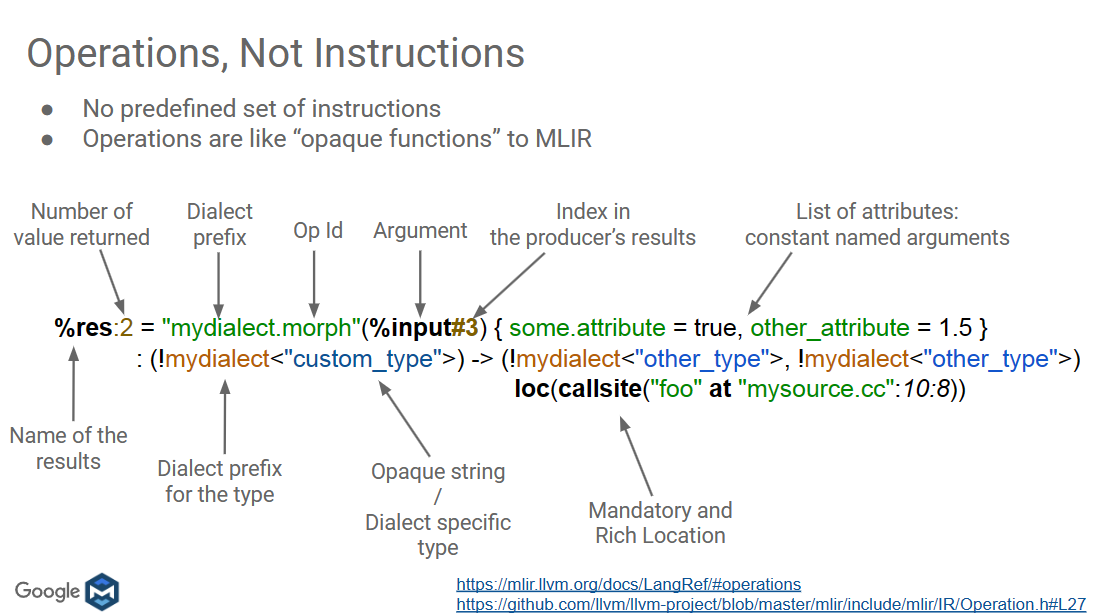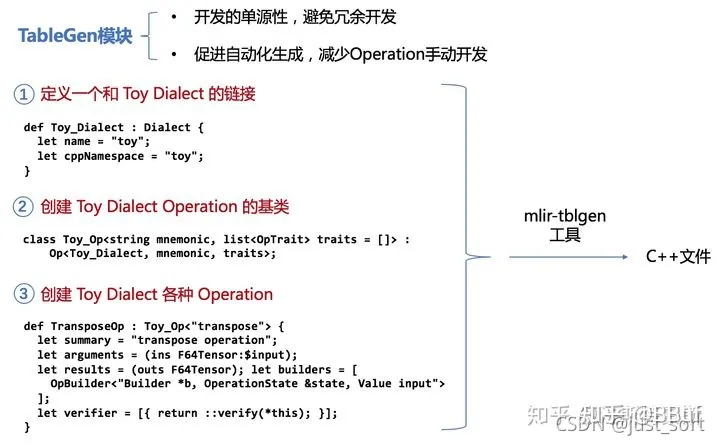MLIR Toy Tutorial
1. Toy and AST
Toy语言,一个基于tensor的语言,可以定义函数,执行一些数学运算和输出结果。简单起见,tensor的rank <= 2,只有f64一种类型,并且值不可修改,需要新创建,并自动管理其释放,这一点类似于函数式编程语言。一个例子
def main() {
# Define a variable `a` with shape <2, 3>, initialized with the literal value.
# The shape is inferred from the supplied literal.
var a = [[1, 2, 3], [4, 5, 6]];
# b is identical to a, the literal tensor is implicitly reshaped: defining new
# variables is the way to reshape tensors (element count must match).
var b<2, 3> = [1, 2, 3, 4, 5, 6];
# transpose() and print() are the only builtin, the following will transpose
# a and b and perform an element-wise multiplication before printing the result.
print(transpose(a) * transpose(b));
}Type checking is statically performed through type inference.
Toy语言只续在必要时指定张量形状的Type Declaration。函数是一个泛型函数,参数的类型是不知道的,只有调用时会特化。
# User defined generic function that operates on unknown shaped arguments.
def multiply_transpose(a, b) {
return transpose(a) * transpose(b);
}
def main() {
# Define a variable `a` with shape <2, 3>, initialized with the literal value.
var a = [[1, 2, 3], [4, 5, 6]];
var b<2, 3> = [1, 2, 3, 4, 5, 6];
# This call will specialize `multiply_transpose` with <2, 3> for both
# arguments and deduce a return type of <3, 2> in initialization of `c`.
var c = multiply_transpose(a, b);
# A second call to `multiply_transpose` with <2, 3> for both arguments will
# reuse the previously specialized and inferred version and return <3, 2>.
var d = multiply_transpose(b, a);
# A new call with <3, 2> (instead of <2, 3>) for both dimensions will
# trigger another specialization of `multiply_transpose`.
var e = multiply_transpose(c, d);
# Finally, calling into `multiply_transpose` with incompatible shapes
# (<2, 3> and <3, 2>) will trigger a shape inference error.
var f = multiply_transpose(a, c);
}使用以下命令生成Toy程序的AST
cd llvm-project/build/bin
./toyc-ch1 ../../mlir/test/Examples/Toy/Ch1/ast.toy --emit=ast如下
Module:
Function
Proto 'multiply_transpose' @../../mlir/test/Examples/Toy/Ch1/ast.toy:4:1
Params: [a, b]
Block {
Return
BinOp: * @../../mlir/test/Examples/Toy/Ch1/ast.toy:5:25
Call 'transpose' [ @../../mlir/test/Examples/Toy/Ch1/ast.toy:5:10
var: a @../../mlir/test/Examples/Toy/Ch1/ast.toy:5:20
]
Call 'transpose' [ @../../mlir/test/Examples/Toy/Ch1/ast.toy:5:25
var: b @../../mlir/test/Examples/Toy/Ch1/ast.toy:5:35
]
} // Block
Function
Proto 'main' @../../mlir/test/Examples/Toy/Ch1/ast.toy:8:1
Params: []
Block {
VarDecl a<> @../../mlir/test/Examples/Toy/Ch1/ast.toy:11:3
Literal: <2, 3>[ <3>[ 1.000000e+00, 2.000000e+00, 3.000000e+00], <3>[ 4.000000e+00, 5.000000e+00, 6.000000e+00]] @../../mlir/test/Examples/Toy/Ch1/ast.toy:11:11
VarDecl b<2, 3> @../../mlir/test/Examples/Toy/Ch1/ast.toy:15:3
Literal: <6>[ 1.000000e+00, 2.000000e+00, 3.000000e+00, 4.000000e+00, 5.000000e+00, 6.000000e+00] @../../mlir/test/Examples/Toy/Ch1/ast.toy:15:17
VarDecl c<> @../../mlir/test/Examples/Toy/Ch1/ast.toy:19:3
Call 'multiply_transpose' [ @../../mlir/test/Examples/Toy/Ch1/ast.toy:19:11
var: a @../../mlir/test/Examples/Toy/Ch1/ast.toy:19:30
var: b @../../mlir/test/Examples/Toy/Ch1/ast.toy:19:33
]
VarDecl d<> @../../mlir/test/Examples/Toy/Ch1/ast.toy:22:3
Call 'multiply_transpose' [ @../../mlir/test/Examples/Toy/Ch1/ast.toy:22:11
var: b @../../mlir/test/Examples/Toy/Ch1/ast.toy:22:30
var: a @../../mlir/test/Examples/Toy/Ch1/ast.toy:22:33
]
VarDecl e<> @../../mlir/test/Examples/Toy/Ch1/ast.toy:25:3
Call 'multiply_transpose' [ @../../mlir/test/Examples/Toy/Ch1/ast.toy:25:11
var: c @../../mlir/test/Examples/Toy/Ch1/ast.toy:25:30
var: d @../../mlir/test/Examples/Toy/Ch1/ast.toy:25:33
]
VarDecl f<> @../../mlir/test/Examples/Toy/Ch1/ast.toy:28:3
Call 'multiply_transpose' [ @../../mlir/test/Examples/Toy/Ch1/ast.toy:28:11
var: a @../../mlir/test/Examples/Toy/Ch1/ast.toy:28:30
var: c @../../mlir/test/Examples/Toy/Ch1/ast.toy:28:33
]
} // Block词法解析与语法解析在以下路径
examples/toy/Ch1/include/toy/Lexer.h
examples/toy/Ch1/include/toy/Parser.h2. Emitting Basic MLIR
2.1 Intro
其他编译器,如 LLVM,提供了一组固定的预定义类型和(通常是低级/类 RISC)指令。在输出 LLVM IR 之前,特定语言的前端需要执行任何特定语言的类型检查、分析或转换。例如,Clang 不仅会使用其 AST 进行static analysis,还会进行transformations,如通过 AST 克隆和重写进行 C++ 模板实例化。最后,在比 C/C++ 更高层次上进行构造的语言可能需要对其 AST 进行non-trivial lowering,才能生成 LLVM IR。
因此,多个前端最终都要重新实现大量的基础架构,以支持这些分析和转换的需要。MLIR 通过设计可扩展性解决了这一问题。因此,很少有预定义的指令(MLIR 术语中的操作)或类型。
MLIR是一个完全可扩展的基础架构,没有封闭的属性集、操作和类型。通过Dialect来支持可扩展性,方言提供了一种分组机制,可在特定的namespace下进行抽象。
MLIR中Operations是一个Abstraction和Computaion核心单元,和LLVM指令类似。

%t_tensor = "toy.transpose"(%tensor) {inplace = true} : (tensor<2x3xf64>) -> tensor<3x2xf64> loc("example/file/path":12:1)注意到MLIR中有一个loc,loc是MLIR的核心要求,APIs依赖并操作它,除非显式drop,如果一个operation被转换成另一个,可以通过loc来跟踪。
2.2 Defining a Toy Dialect
C++定义
/// This is the definition of the Toy dialect. A dialect inherits from
/// mlir::Dialect and registers custom attributes, operations, and types. It can
/// also override virtual methods to change some general behavior, which will be
/// demonstrated in later chapters of the tutorial.
class ToyDialect : public mlir::Dialect {
public:
explicit ToyDialect(mlir::MLIRContext *ctx);
/// Provide a utility accessor to the dialect namespace.
static llvm::StringRef getDialectNamespace() { return "toy"; }
/// An initializer called from the constructor of ToyDialect that is used to
/// register attributes, operations, types, and more within the Toy dialect.
void initialize();
};TableGen定义
// Provide a definition of the 'toy' dialect in the ODS framework so that we
// can define our operations.
def Toy_Dialect : Dialect {
// The namespace of our dialect, this corresponds 1-1 with the string we
// provided in `ToyDialect::getDialectNamespace`.
let name = "toy";
// A short one-line summary of our dialect.
let summary = "A high-level dialect for analyzing and optimizing the "
"Toy language";
// A much longer description of our dialect.
let description = [{
The Toy language is a tensor-based language that allows you to define
functions, perform some math computation, and print results. This dialect
provides a representation of the language that is amenable to analysis and
optimization.
}];
// The C++ namespace that the dialect class definition resides in.
let cppNamespace = "toy";
}使用mlir-tblgen选择gen-dialect-decls可查看生成的C++ source code
${build_root}/bin/mlir-tblgen -gen-dialect-decls ${mlir_src_root}/examples/toy/Ch2/include/toy/Ops.td -I ${mlir_src_root}/include/如下
namespace mlir {
namespace toy {
class ToyDialect : public ::mlir::Dialect {
explicit ToyDialect(::mlir::MLIRContext *context);
void initialize();
friend class ::mlir::MLIRContext;
public:
~ToyDialect() override;
static constexpr ::llvm::StringLiteral getDialectNamespace() {
return ::llvm::StringLiteral("toy");
}
};
} // namespace toy
} // namespace mlir
MLIR_DECLARE_EXPLICIT_TYPE_ID(::mlir::toy::ToyDialect)2.3 Defining Toy Operations
创建一个toy.constant Operation表示常量
%4 = "toy.constant"() {value = dense<1.0> : tensor<2x3xf64>} : () -> tensor<2x3xf64>An operation class inherits from the CRTP
mlir::Op class which also takes some optional traits
to customize its behavior.Traits are a mechanism with which
we can inject additional behavior into an Operation, such as additional
accessors, verification, and more.
class ConstantOp : public mlir::Op<
/// `mlir::Op` is a CRTP class, meaning that we provide the
/// derived class as a template parameter.
ConstantOp,
/// The ConstantOp takes zero input operands.
mlir::OpTrait::ZeroOperands,
/// The ConstantOp returns a single result.
mlir::OpTrait::OneResult,
/// We also provide a utility `getType` accessor that
/// returns the TensorType of the single result.
mlir::OpTraits::OneTypedResult<TensorType>::Impl> {
public:
/// Inherit the constructors from the base Op class.
using Op::Op;
/// Provide the unique name for this operation. MLIR will use this to register
/// the operation and uniquely identify it throughout the system. The name
/// provided here must be prefixed by the parent dialect namespace followed
/// by a `.`.
static llvm::StringRef getOperationName() { return "toy.constant"; }
/// Return the value of the constant by fetching it from the attribute.
mlir::DenseElementsAttr getValue();
/// Operations may provide additional verification beyond what the attached
/// traits provide. Here we will ensure that the specific invariants of the
/// constant operation are upheld, for example the result type must be
/// of TensorType and matches the type of the constant `value`.
LogicalResult verifyInvariants();
/// Provide an interface to build this operation from a set of input values.
/// This interface is used by the `builder` classes to allow for easily
/// generating instances of this operation:
/// mlir::OpBuilder::create<ConstantOp>(...)
/// This method populates the given `state` that MLIR uses to create
/// operations. This state is a collection of all of the discrete elements
/// that an operation may contain.
/// Build a constant with the given return type and `value` attribute.
static void build(mlir::OpBuilder &builder, mlir::OperationState &state,
mlir::Type result, mlir::DenseElementsAttr value);
/// Build a constant and reuse the type from the given 'value'.
static void build(mlir::OpBuilder &builder, mlir::OperationState &state,
mlir::DenseElementsAttr value);
/// Build a constant by broadcasting the given 'value'.
static void build(mlir::OpBuilder &builder, mlir::OperationState &state,
double value);
};在ToyDialect initialize中注册operation
void ToyDialect::initialize() {
addOperations<ConstantOp>();
}2.4 Op vs Operation
Op是Operation的智能指针装饰器
void processConstantOp(mlir::Operation *operation) {
ConstantOp op = llvm::dyn_cast<ConstantOp>(operation);
// This operation is not an instance of `ConstantOp`.
if (!op)
return;
// Get the internal operation instance wrapped by the smart pointer.
mlir::Operation *internalOperation = op.getOperation();
assert(internalOperation == operation &&
"these operation instances are the same");
}2.5 ODS
定义Operation的基类,Toy_Op
// Base class for toy dialect operations. This operation inherits from the base
// `Op` class in OpBase.td, and provides:
// * The parent dialect of the operation.
// * The mnemonic for the operation, or the name without the dialect prefix.
// * A list of traits for the operation.
class Toy_Op<string mnemonic, list<Trait> traits = []> :
Op<Toy_Dialect, mnemonic, traits>;ODS定义的ConstantOp
def ConstantOp : Toy_Op<"constant"> {
...
// Add custom build methods for the constant operation. These methods populate
// the `state` that MLIR uses to create operations, i.e. these are used when
// using `builder.create<ConstantOp>(...)`.
let builders = [
// Build a constant with a given constant tensor value.
OpBuilder<(ins "DenseElementsAttr":$value), [{
// Call into an autogenerated `build` method.
build(builder, result, value.getType(), value);
}]>,
// Build a constant with a given constant floating-point value. This builder
// creates a declaration for `ConstantOp::build` with the given parameters.
OpBuilder<(ins "double":$value)>
];
}可通过以下命令查看
./mlir-tblgen -gen-op-defs ../../examples/toy/Ch2/include/toy/Ops.td -I ../../mlir/include/2.6 Summary
通过以下命令生成MLIR
./toyc-ch2 ../../mlir/test/Examples/Toy/Ch2/codegen.toy -emit=mlir -mlir-print-debuginfo如下
module {
toy.func @multiply_transpose(%arg0: tensor<*xf64> loc("../../mlir/test/Examples/Toy/Ch2/codegen.toy":4:1), %arg1: tensor<*xf64> loc("../../mlir/test/Examples/Toy/Ch2/codegen.toy":4:1)) -> tensor<*xf64> {
%0 = toy.transpose(%arg0 : tensor<*xf64>) to tensor<*xf64> loc("../../mlir/test/Examples/Toy/Ch2/codegen.toy":5:10)
%1 = toy.transpose(%arg1 : tensor<*xf64>) to tensor<*xf64> loc("../../mlir/test/Examples/Toy/Ch2/codegen.toy":5:25)
%2 = toy.mul %0, %1 : tensor<*xf64> loc("../../mlir/test/Examples/Toy/Ch2/codegen.toy":5:25)
toy.return %2 : tensor<*xf64> loc("../../mlir/test/Examples/Toy/Ch2/codegen.toy":5:3)
} loc("../../mlir/test/Examples/Toy/Ch2/codegen.toy":4:1)
toy.func @main() {
%0 = toy.constant dense<[[1.000000e+00, 2.000000e+00, 3.000000e+00], [4.000000e+00, 5.000000e+00, 6.000000e+00]]> : tensor<2x3xf64> loc("../../mlir/test/Examples/Toy/Ch2/codegen.toy":9:17)
%1 = toy.reshape(%0 : tensor<2x3xf64>) to tensor<2x3xf64> loc("../../mlir/test/Examples/Toy/Ch2/codegen.toy":9:3)
%2 = toy.constant dense<[1.000000e+00, 2.000000e+00, 3.000000e+00, 4.000000e+00, 5.000000e+00, 6.000000e+00]> : tensor<6xf64> loc("../../mlir/test/Examples/Toy/Ch2/codegen.toy":10:17)
%3 = toy.reshape(%2 : tensor<6xf64>) to tensor<2x3xf64> loc("../../mlir/test/Examples/Toy/Ch2/codegen.toy":10:3)
%4 = toy.generic_call @multiply_transpose(%1, %3) : (tensor<2x3xf64>, tensor<2x3xf64>) -> tensor<*xf64> loc("../../mlir/test/Examples/Toy/Ch2/codegen.toy":11:11)
%5 = toy.generic_call @multiply_transpose(%3, %1) : (tensor<2x3xf64>, tensor<2x3xf64>) -> tensor<*xf64> loc("../../mlir/test/Examples/Toy/Ch2/codegen.toy":12:11)
toy.print %5 : tensor<*xf64> loc("../../mlir/test/Examples/Toy/Ch2/codegen.toy":13:3)
toy.return loc("../../mlir/test/Examples/Toy/Ch2/codegen.toy":8:1)
} loc("../../mlir/test/Examples/Toy/Ch2/codegen.toy":8:1)
} loc(unknown)
我们需要弄清楚codegen.toy是如何产生的MLIR文件。也即下图的AST到MLIR表达式那部分(包含Dialect)。

这里首先有一个MLIRGen函数负责遍历AST。在mlir/examples/toy/Ch2/mlir/MLIRGen.cpp文件中实现,里面有一个mlirGen函数,实现如下:
/// Dispatch codegen for the right expression subclass using RTTI.
mlir::Value mlirGen(ExprAST &expr) {
switch (expr.getKind()) {
case toy::ExprAST::Expr_BinOp:
return mlirGen(cast<BinaryExprAST>(expr));
case toy::ExprAST::Expr_Var:
return mlirGen(cast<VariableExprAST>(expr));
case toy::ExprAST::Expr_Literal:
return mlirGen(cast<LiteralExprAST>(expr));
case toy::ExprAST::Expr_Call:
return mlirGen(cast<CallExprAST>(expr));
case toy::ExprAST::Expr_Num:
return mlirGen(cast<NumberExprAST>(expr));
default:
emitError(loc(expr.loc()))
<< "MLIR codegen encountered an unhandled expr kind '"
<< Twine(expr.getKind()) << "'";
return nullptr;
}
}这个函数会根据AST中的节点类型递归调用其它的mlirGen子函数,并在各个子函数完成真正的转换MLIR表达式的操作。以上面codege.toy的transpose(a)操作为例,对应的mlirGen子函数
/// Emit a call expression. It emits specific operations for the `transpose`
/// builtin. Other identifiers are assumed to be user-defined functions.
mlir::Value mlirGen(CallExprAST &call) {
llvm::StringRef callee = call.getCallee();
auto location = loc(call.loc());
// Codegen the operands first.
SmallVector<mlir::Value, 4> operands;
for (auto &expr : call.getArgs()) {
auto arg = mlirGen(*expr);
if (!arg)
return nullptr;
operands.push_back(arg);
}
// Builtin calls have their custom operation, meaning this is a
// straightforward emission.
if (callee == "transpose") {
if (call.getArgs().size() != 1) {
emitError(location, "MLIR codegen encountered an error: toy.transpose "
"does not accept multiple arguments");
return nullptr;
}
return builder.create<TransposeOp>(location, operands[0]);
}
// Otherwise this is a call to a user-defined function. Calls to
// user-defined functions are mapped to a custom call that takes the callee
// name as an attribute.
return builder.create<GenericCallOp>(location, callee, operands);
}我们可以看到if (callee == "transpose")这里是对函数签名进行判断,如果是transpose
那么就需要新建一个TransposeOp类型的MLIR节点,即builder.create<TransposeOp>(location, operands[0])




